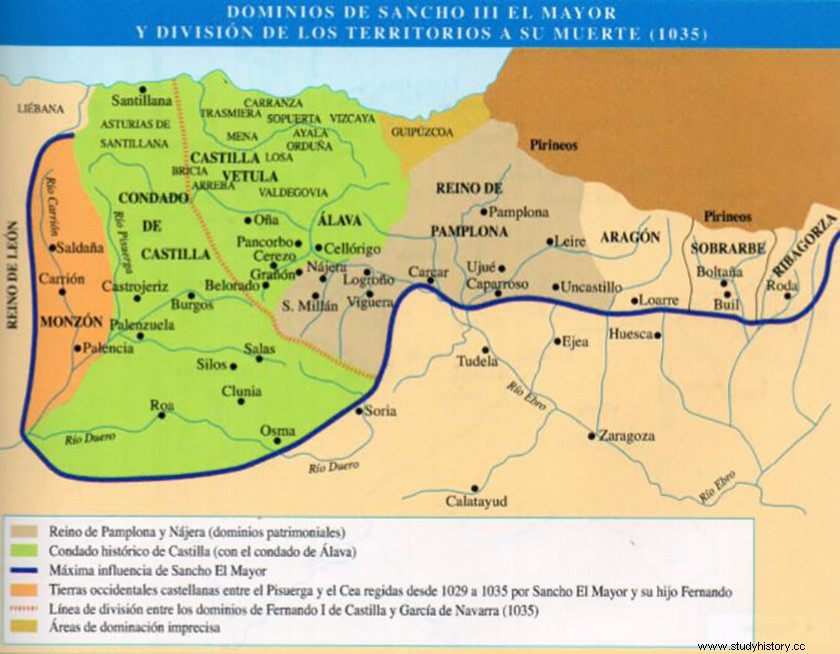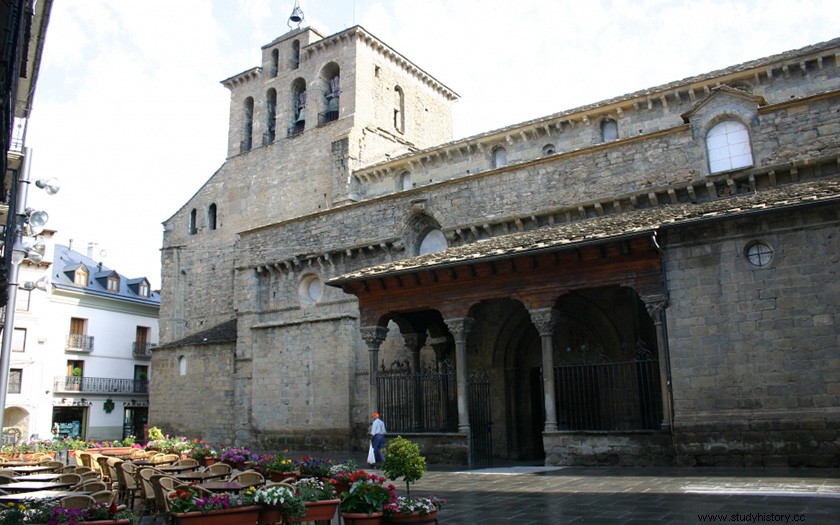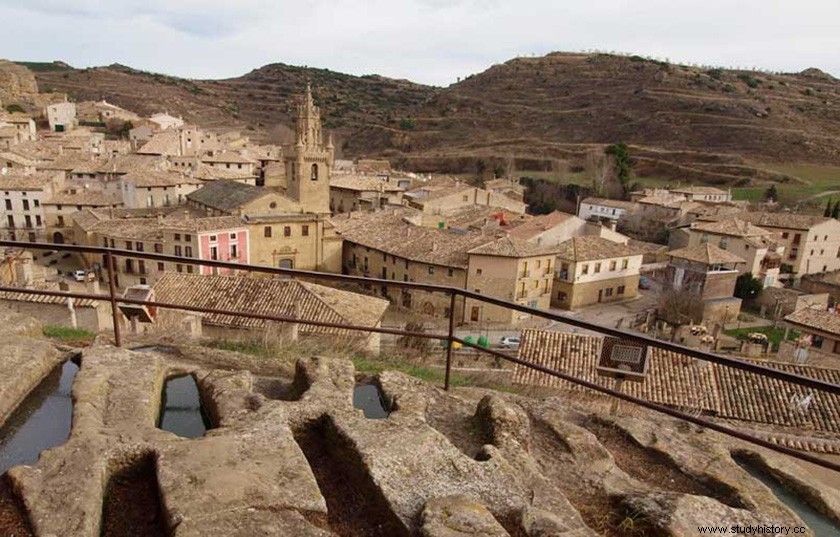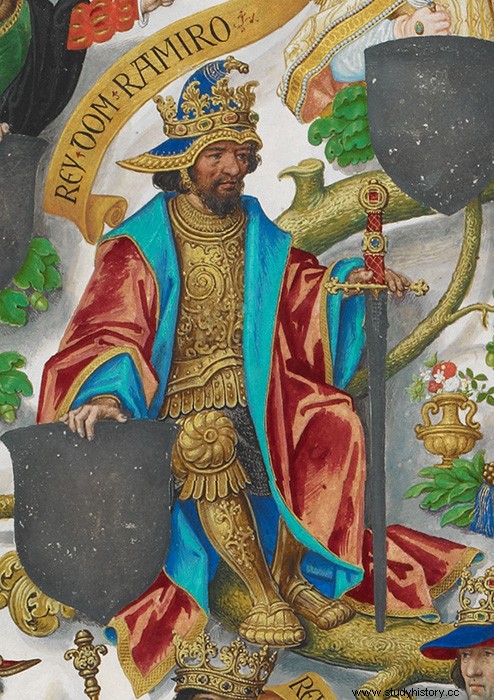
We discover nothing if we say that the Kingdom of Aragon , later the Crown of Aragon, became one of the most powerful kingdoms in the Mediterranean in the Middle Ages. His domains ranged from the Pyrenees to the south of Alicante, without forgetting much of southern Italy and almost all the western islands of the Mare Nostrum. Well, all this began in a small corner of the Pyrenees, from the hand of a man who seemed to end up there to collect the crumbs of one of the most powerful kings, who knew the Christian kingdoms of the Iberian Peninsula in the High Middle Ages.
Ramiro's little inheritance.
In the autumn of the year 1035, the king of Pamplona, Sancho el Mayor, died in Castilian lands. At that time, the Kingdom of Pamplona, together with the Kingdom of León, were the two great Christian kingdoms of the Iberian Peninsula. Sancho's domains practically reached from the current Valle de Aran to Palencia.

The distribution of his territories will lead to great problems between his children in the near future, due to the imprecise border lines between the territories granted to each of them. Sancho had married the Castilian heiress Muniadona. The division of the cake belonged to their sons, García, the eldest of them, became king of Pamplona, Fernando took control of the County of Castile, while the smallest of the family corresponded to the easternmost territories of Sobrarbe and Ribagorza.
Our protagonist Ramiro, born before any of them during Sancho's single days, was assigned the territories of the County of Aragon. It is true that it was the smallest piece of territory of all those distributed by the king of Pamplona, but those territories had their own personality. The small Christian county had been born two centuries earlier under the protection of the Emperor Charlemagne, in the so-called Hispanic March, which served as a buffer between the Frankish Kingdom and the Muslim territories of the Iberian Peninsula. This territory had fallen under the umbrella of the Kingdom of Pamplona a century earlier, when Andregoto Galindez, despite her name Countess of Aragon, became queen consort of Pamplona after her marriage to García Sánchez I.
Going back to Ramiro, we can point out that he did not reach territories unknown to him, since he had served in the recent past as a delegate of his father's royal power in these territories, and possibly it ended up in them after his death in a similar condition. But the truth is that from the first moment he arrived in Jaca, the small county capital, he exercised an emancipating power over the new king of Pamplona.

Jaca Cathedral erected after the death of Ramiro I
Certainly the territory inherited by Ramiro offered some difficulties in organizing an independent territory. Its orography did not help this, various valleys that descended from the Pyrenean mountains, such as Hecho, Roncal or Ansó and that its best communication was to the south, on a small plain located between the Pyrenees and the pre-Pyrenees mountain ranges, where the Monastery of San Juan de la Peña.
Ramiro's task was to surround himself with faithful companions, nobility and clergy, to the former he offered territories where they could develop economically. While the Cluniac monks arrived there after the call of his father Sancho, he offered them the opportunity to build their own monasteries, thus the Samitier or San Juan de Pano monasteries were born, both disappeared today. Soon the latter will be in charge of starting to address Ramiro as their very Christian king.
To make the kingdom great
Like any medieval kingdom, the kingdom of Ramiro had the need to vindicate itself, and this inexorably passed through the expansion of its borders. To the south it was complicated, since the Muslims of the Taifa of Zaragoza had a much better prepared army than Ramiro. To the east was Gonzalo's little brother, who seemed much more vulnerable than the territories Ramiro had chosen to begin his expansion. His attack went directly to the kingdom of Pamplona, without a doubt a movement that raises many questions, both the motives and the final result.
The battle with el García de el's brother took place near Tafalla in the year 1043, some sources indicate that he had the support of the Muslim Taifa of Zaragoza. The truth is that Ramiro's defeat was as great as predictable, not in vain Pamplona had an army with more experience and greater than that of the young kingdom of Aragon. But after both brothers sign peace, new territories fall from the sky to Ramiro, and never better said, since the most logical explanation is mediation in the Cluniac conflict. In short, he received a border line of castles with the Muslims, such as Sos, Uncastillo, or Agüero. To the previous explanation of the donation by García of these new sites to his brother Ramiro de él, we can add others, such as the need for a new partner in the struggle between Pamploneses and Castilians. Or give him work to defend them, to get rid of an enemy. Be that as it may, Ramiro had gotten his first expansion and now everyone knew him as the King of Aragon.

Medieval tombs of Uncastillo
The next expansion of the newborn kingdom of Aragon we can think that it was presided over by logic. Let us remember that the inheritance of Sancho el Mayor had left the counties of Sobrarbe and Ribagorza in the hands of Gonzalo. This Gonzalo, is one of the most unknown characters in this story, we can say that both his life and his death are full of mystery. Some affirm that he never even left the Court of Nájera in his life, protected by his older brother, the King of Pamplona. Others assure, according to what was found in the monastery of San Juan de la Peña, that Gonzalo died when the summer of 1045 arrived, pierced by a spear that had emerged from the hands of one of his vassals, on a bridge that connected his own counties.
It was one way or another, it was necessary to take charge of the territories of young Gonzalo. The nobility of both counties had it clear, with enemies to the east, the County of Pallars, and to the south, the Taifa of Zaragoza, both willing to take over these territories, they decided to place themselves in the hands of the king of Pamplona. Logically this, as he had done two years before, leaves the problem in Ramiro's hands. We could well think that García Sánchez III was not very aware of the great power that he was giving to his stepbrother.
After ten more years of continuous minor incorporations, the small county that Ramiro had inherited, had become the Kingdom of Aragon, and also now had a magnificent geographical exit to the south, through the valleys of the Cinca and Ribagorzana rivers. The only problem, the rival that was going to be found, the Muslims of the Taifa of Zaragoza, who were also not alone.
The death of the first king of Aragon.
Ramiro's new needs for the expansion of the kingdom were to find better land for growing cereals. The Hoya de Huesca offered a magnificent opportunity, but to win it, he had to overcome the resistance of the jewel in the crown of King al-Muqtadir in the region, the town of Barbastro. His best point of access to the area was the Ribagorzana river valley, where the Graus fortress defended the pass.

Curious image attributed to Ramiro I, first king of the Kingdom of Aragon
There we find our protagonist in the year 1063, preparing the final assault on the Moorish castle from his tent. In front of him a Christian army, to make matters worse his own brother now known as Fernando I of Castile, in his work as protector of his Muslim outcasts. I invite you to discover the last moments of Ramiro I in the following article:rodrigo-diaz-de-vivar
Ramiro I died betrayed by a Mozarabic, apparently the Aragonese king had good relations with some of these men settled in the border villages between Christians and Muslims. But fortunately for the newly born Kingdom of Aragon, his heirs also inherited his conquering tenacity. That same year with the help of the Crusades Barbastro fell, 33 years later it was Huesca's turn and 57 years later the Aragonese king Alfonso I entered Zaragoza. That little corner of the Pyrenees, inherited by a bastard, was poised to become the most important commercial and military power in the western Mediterranean.
More info:
Moors and Christians, the great adventure of Medieval Spain, Juan José Esparza, Ed. The sphere of books, 2011.
History of Spain in the Middle Ages, Cood. Vicente Ángel Álvarez Palenzuela, Ed. Ariel, 2011.
